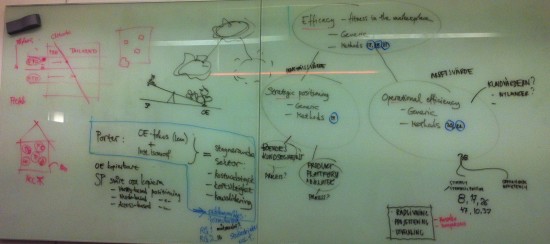Lean is great. We identify what activities provide client value and improve them. We then identify what activities do not provide client value and eliminate them. We then start over. Piece of cake? Well. It sounds easy, but the actual implementation is hard because for construction it requires a new mind-set. People tend to adopt new ideas easily but abandon their old ones reluctantly. It is a long haul to make Lean happen, a long haul that requires determination and patience on all levels of the company.
The last few days I’ve spent with Karin Gustafsson, a doctoral candidate I work with, discussing the focus for the first phase of her work. She brought to my attention a couple of classic papers in this field. Let’s combine them and see what happens. The first one was written by Michael Porter in 1996. Porter indicates the long-term effects of such focus on management methods. Porter points to the risk of allowing methods take the place of strategy.

The very first mind-map of Karin’s research field is mostly useful for Karin. 🙂
The hard focus needed to successfully implement management tools for operational efficiency makes it hard to keep our eyes on the ball; our long-term strategy for providing client value better than our competitors. Our business plan is not to cut costs, it is to create value. Cutting costs is good but the reason people buy a house is not that it is cheap. The reason is because it gives them somewhere to live. That’s our business. That’s what we do. What is our long-term strategy for providing that value better than our competitors? Partnering, Last Planner, benchmarking, outsourcing and what have you are tools in this. Porter argues that these methods do not provide sustainable profitability because they are so easy to imitate. This goes for Lean too. According to Porter, we cannot allow these tools to replace that we choose a unique position based on our activities. That is much more difficult to copy.
The other paper that Karin pointed out was written by DiMaggio and Powell in 1983 and points to how institutions mimic each other into a homogenous organizational structure. If a handful of us start doing something and look successful, the ones that are left are likely to follow suit. The authors build on isomorphism; the “constraining process that forces one unit in a population to resemble other units that face the same set of environmental conditions”. DiMaggio and Powell point to ten predictors of the extent and speed of isomorphism, and arguably construction falls under at seven of them. Check them out and see if you agree. My conclusion (and experience) is that in construction, we are likely to try to keep up with the Joneses.
So, what are the Joneses doing? Right now, one ubiquitous buzz word in construction is … drumroll … Lean. There are Lean Institutes, Lean consultants and DIY Lean articles cropping up pretty much everywhere. Will most of us jump on the Lean bandwagon? We fall under seven out of ten predictors, so DiMaggio and Powell say Yes. Will it provide us with sustainable profit? We focus hard on implementation of Lean, so Porter says No. And here’s the really scary thing. Porter also states that such development leads to a stagnating sector, to a situation where the competitive edge is price rather than value-creation. Porter tracks the development to quick-fixes and consolidation – to when larger companies buy slightly smaller companies in order to increase their market share, which is the only option left to significantly improve profits. Now that wiser people have pointed this out to me, I can see this happening in construction.
I don’t know about you, but I’m scared stiff. Again. Construction researchers of the world, unite.
References:
Porter, M. E. (1996) What is a strategy? Harvard Business Review (November-December): 61-78.
DiMaggio, P.J. & Powell , W. (1983). The iron cage revisited. Institutional isomorphism and collective rationality in organizational fields, American Sociological Review, 48 (1983), 147-60.
Image: The very first research field mind-map for Karin (photo by Dan).

 Facebook
Facebook
Lämna ett svar